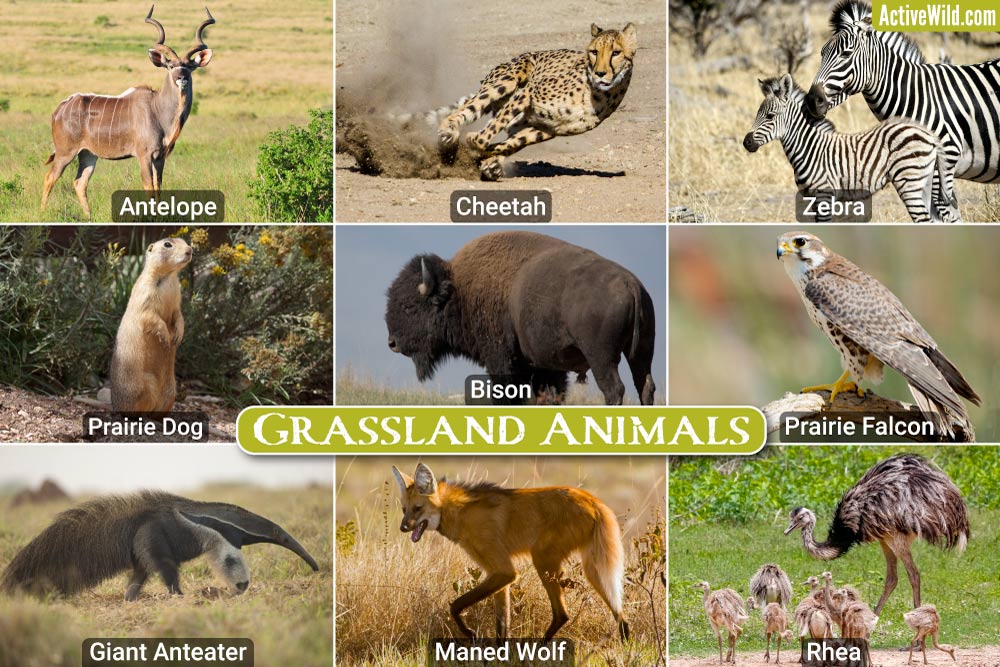Grassland animals include mammals such as antelopes, cheetah, zebras, eastern grey kangaroo, Pallas’s cat, Przewalski’s horse, American bison, giant anteater and maned wolf; birds such as the plains-wanderer, Steppe eagle, prairie falcon and rhea, and reptiles such as the prairie rattlesnake and leopard tortoise.
On this page you’ll find facts and information on these and many other grassland animals...
Grasslands
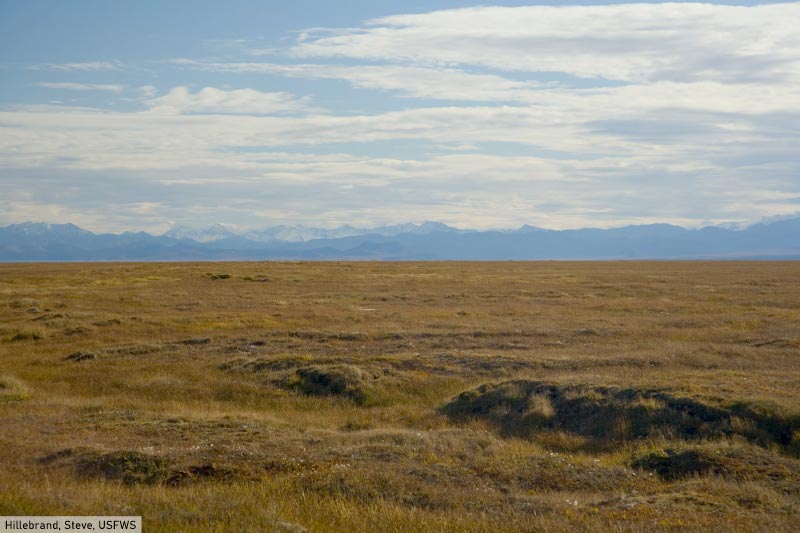
A grassland is an area in which the dominant plants are grasses. Grasses are flowering plants belonging to the family Poaceae. Other, grass-like, plants such as sedges (plants of family Cyperaceae), and rushes (plants of family Juncaceae) are also often present in grasslands.
Grasslands cover a large proportion of Earth’s land area (estimates as to exactly how much range from 30% to 70%). Grasslands are found on every continent except Antarctica, and are home to a vast array of animals.
The Great Plains of North America; the Pampas of South America and the Great Steppe of Asia are among the world’s largest and most famous grasslands. Other words for grassland areas include veld (also spelled veldt) and prairie.
- You can find out more about grasslands on this page: Grassland Biome Facts
Grassland Animal Adaptations
Grasslands are typically open habitats with few trees. With no cover in which to hide, grassland herbivores are often fast runners with acute senses, always on the look-out for danger. Grassland predators have also adapted to a lack of shelter by being stealthy, well-camouflaged, and being capable of running either at great speed or for long distances.
Many of the world’s grasslands are arid (dry) places, and as a result, animals that live in grasslands often have adaptations for coping with a lack of readily-available water.
In the list of grassland animals below, you’ll find examples of grassland animals from all over the world, divided by the continent on which they are found.
Grassland Animals List
Grassland Animals of Africa
Grassland Animals Of Australia
Grassland Animals of Eurasia
- Corsac Fox
- Eastern Imperial Eagle
- Great Bustard
- Pallas’s Cat
- Przewalski’s Horse
- Saiga Antelope
- Steppe Eagle
Grassland Animals of North America
- American Badger
- American Bison
- Burrowing Owl
- Coyote
- Great Plains Toad
- Prairie Falcon
- Prairie Dogs
- Prairie Rattlesnake
- Swift Fox
Grassland Animals Of South America
Grassland Animals of Africa
Aardvark
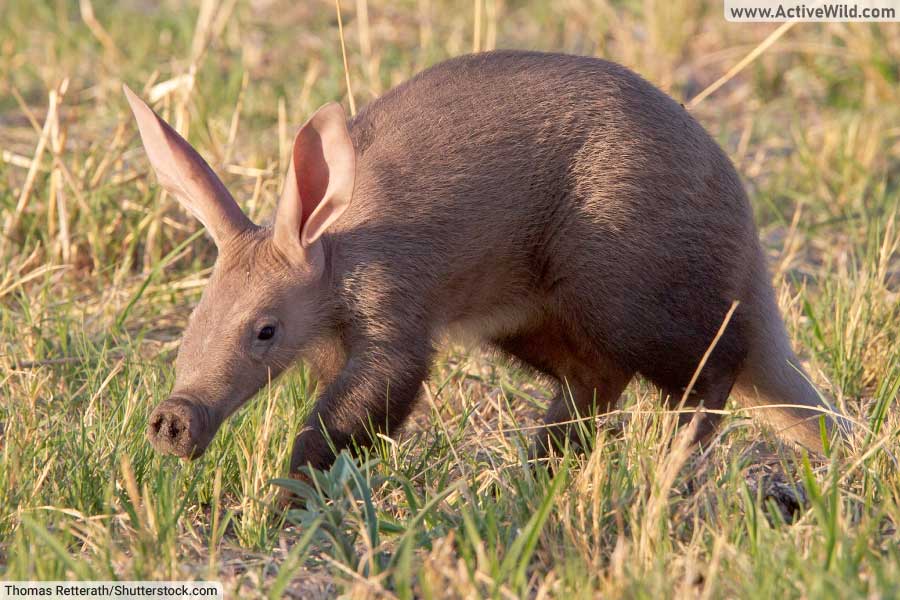
- Scientific name: Orycteropus afer
- Type of animal: Mammal
- Animal family: Orycteropodidae
- Conservation status: Least Concern
The aardvark is a nocturnal, burrowing mammal found in grasslands, savannas and woodlands in sub-Saharan Africa.
The aardvark’s diet consists almost entirely of ants and termites, but the species is also known eat the “aardvark cucumber”, a fruit whose seeds it helps to spread.
The aardvark has powerful legs and strong claws, and is an expert at digging.
The name “aardvark” means “earth pig” in Afrikaans, a language widely-spoken in southern Africa. Despite the name, the aardvark is not related to pigs. In fact, the species’ closest relatives belong to a group of animals, Afrotheria, that evolved in Africa. This group contains animals such as elephants, manatees and tenrecs.
Discover More With Active Wild
You can find out more about the aardvark on this page: Aardvark Facts
Antelope
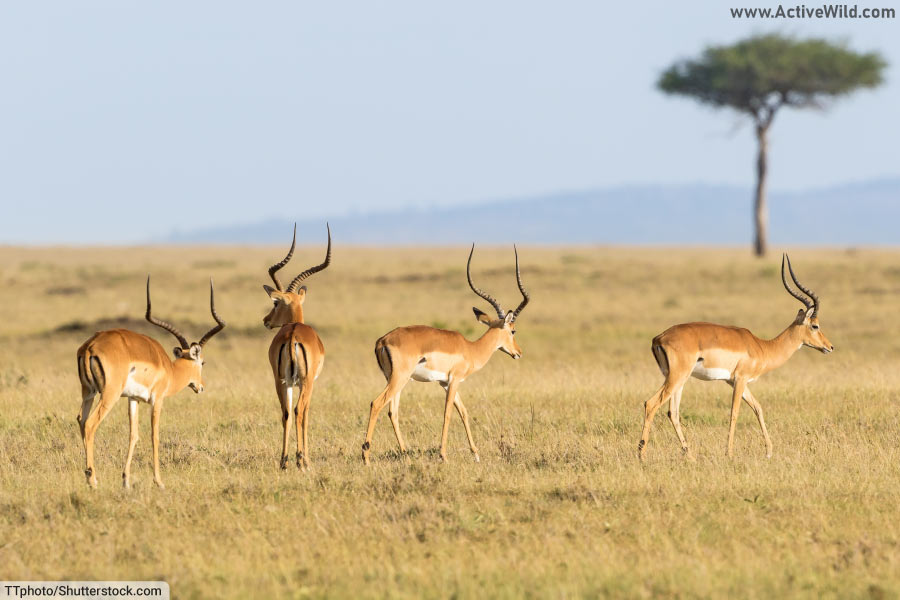
- Type of animal: Mammal
- Animal family: Bovidae
- Genera: Gazella, Nanger, Eudorcas, Antilope
- Conservation status: Various
Antelopes are fast, nimble, hoofed mammals with long, thin legs and slender bodies.
There are 91 antelope species. Most are found on the grasslands and savannas of Africa; the others are found in Asia. Well-known types of antelope include the springbok, gazelles, duikers, elands, oryxes and kudus.
Antelopes vary considerably in size. The largest species, the giant eland, is similar in size to a moose, and more heavily built. The smallest, the royal antelope, is the size of a domestic cat.
In most antelope species, both males and females have horns, although those of the male are usually longer. Unlike the antlers of a deer, which are shed annually, an antelope’s horns grow continuously.
Antelopes are herbivores and usually live in herds.
Antelope species that live in grasslands tend to be faster runners than those that live in less open habitats, as they have nowhere to hide.
Thompson’s gazelle and both wildebeest species, for example, are capable of reaching speeds of up to 50 mph / 80 km/h, while the springbok can reach 55 mph / 90 km/h, and is the world’s third-fastest land animal.
Discover More With Active Wild
You can find out more about antelopes and other horned animals on this page: Animals With Horns
Bilbo's Rain Frog
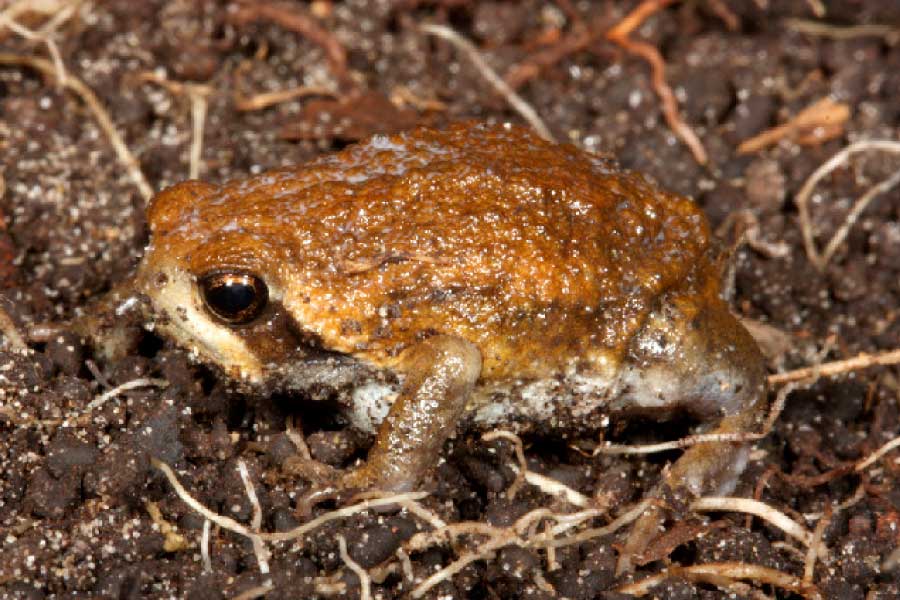
- Scientific name: Breviceps bagginsi
- Type of animal: Amphibian
- Animal family: Brevicipitidae
- Conservation status: Near Threatened
Bilbo’s rain frog is a small amphibian found in the grasslands of South Africa. The species was named after Bilbo Baggins, a character in Tolkien’s novel, The Hobbit. (The zoologist who discovered the frog, L. R. Minter, was a Tolkien fan.)
Reaching lengths of up to 2.87 cm / 1.12992126 in., Bilbo’s rain frog is golden brown in color and has bumpy skin. It spends much of its life underground, burrowing backwards with its short but powerful hind limbs.
Unlike most frogs, Bilbo’s rain frog does not go through a tadpole stage, instead hatching from its egg as a small adult.
The species is an insectivore (insect-eater).
Discover More With Active Wild
You can find out more about amphibians on this page: Amphibians - The Ultimate Guide
Cheetah

- Scientific name: Acinonyx jubatus
- Type of animal: Mammal
- Animal family: Felidae
- Conservation status: Vulnerable
One of the most famous grassland animals, the cheetah is the world’s fastest land animal, capable of speeds of up to 75 mph / 120.7 km/h.
The cheetah is widely distributed throughout most of Africa, and is found in savannas, grasslands, and a variety of other habitats; the main habitats in which it is not found are tropical forests and central Sahara. It is mostly a land dweller, but will occasionally climb trees.
The cheetah has a characteristic yellow-golden coat and is covered with circular dark spots; the cheetah’s face has a distinctive black stripe that starts at the inner corner of each eye and stretches alongside the muzzle. The cat’s distinctive markings provide camouflage while it is stalking its prey.
The cheetah is mostly solitary except for small (all) male coalitions and a female with her cubs. Males and females will only socialize during mating and there is no parental investment from the male.
Like all cat species, the cheetah is a true carnivore. Its diet is made up of animals such as gazelles, impalas, hares, birds, and the offspring of large ungulates.
Discover More With Active Wild
You can find out more about the cheetah on this page: Cheetah Facts
Is a cheetah a true "big cat"? Find out on this page: Big Cats
You can see EVERY species of cat on this page: Wild Cats List
Leopard Tortoise
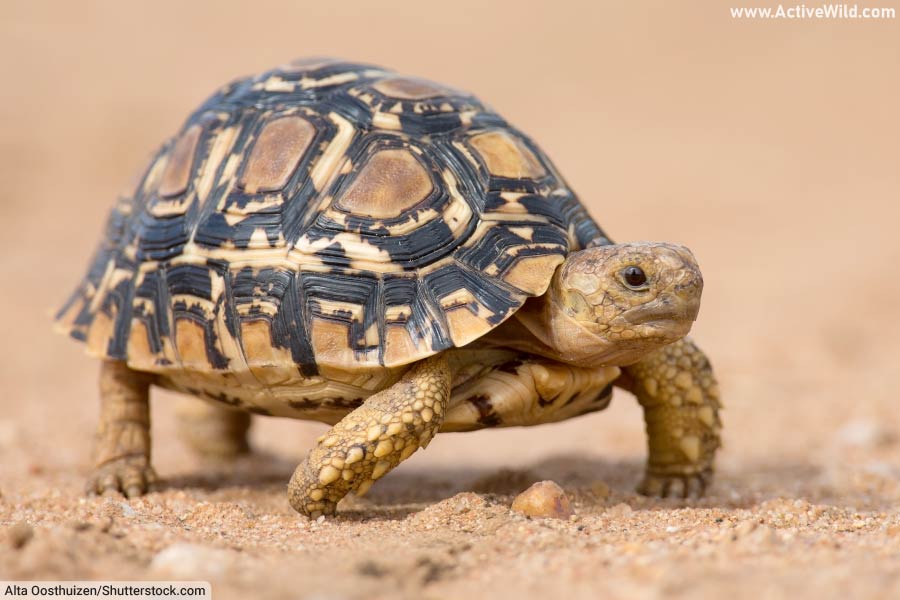
- Scientific name: Stigmochelys pardalis
- Type of animal: Reptile
- Animal family: Testudinidae
- Conservation status: Least Concern
The leopard tortoise is found across a wider area than any other African tortoise. It prefers warmer climates and can be found throughout most of sub-Saharan Africa.
This reptile is thought to be the fourth-largest tortoise species worldwide, with a carapace length of up to 70 cm / 28 in. and a weight of 54 kg / 119 lbs.
The leopard tortoise is mostly herbivorous (around 98% to be exact) but will consume carrion and other animal products if resources are scarce. Unlike other herbivorous tortoise species, which feed mostly on grass, the leopard tortoise prefers to consume fruits and flowers.
This tortoise has a steep, pyramidal carapace that has black and tan, leopard-like patterns from which it gets its name. These colors serve as perfect camouflage for the grasslands and dry plains it inhabits.
Discover More With Active Wild
Discover more tortoises and turtles on this page: Types of Turtles
Find out more about reptiles on this page: Reptiles - The Ultimate Guide
Lion
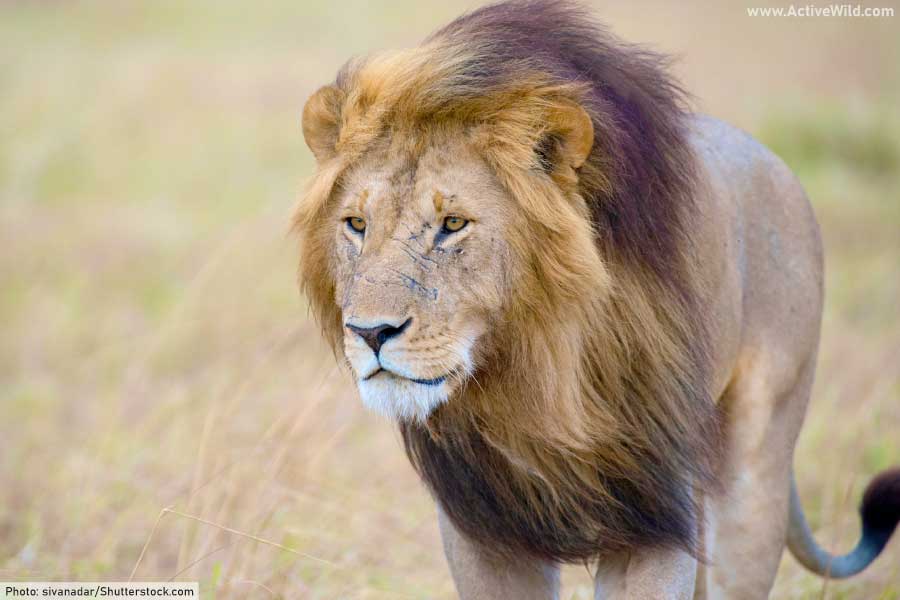
- Scientific name: Panthera leo
- Type of animal: Mammal
- Animal family: Felidae
- Conservation status: Vulnerable
The lion is the world’s second-largest cat species (only the tiger is larger) and it displays a very pronounced case of sexual dimorphism, with the male lion having a characteristic mane and being significantly larger than the female.
The lion is the only big feline that lives and hunts within social groups called “prides”. A pride can have anywhere from 2 to 40 individuals, but usually comprises around a dozen females, one dominant male, a couple of low-ranking males, and cubs.
The lion is an apex predator that hunts prey much larger than itself, such as buffalos, wildebeests, and even giraffes. The lion doesn’t eat every day, but when it does eat it usually consumes around 20% of its body weight.
The main threat to lions is persecution by humans. Lions are killed due to the perceived threat they pose to people and livestock. They are also hunted for sport and for their body parts, and captured for sale to the pet trade.
Discover More With Active Wild
You can find out more about lions on this page: Lion Facts
You can see EVERY species of cat on this page: Wild Cats List
Rhinoceros
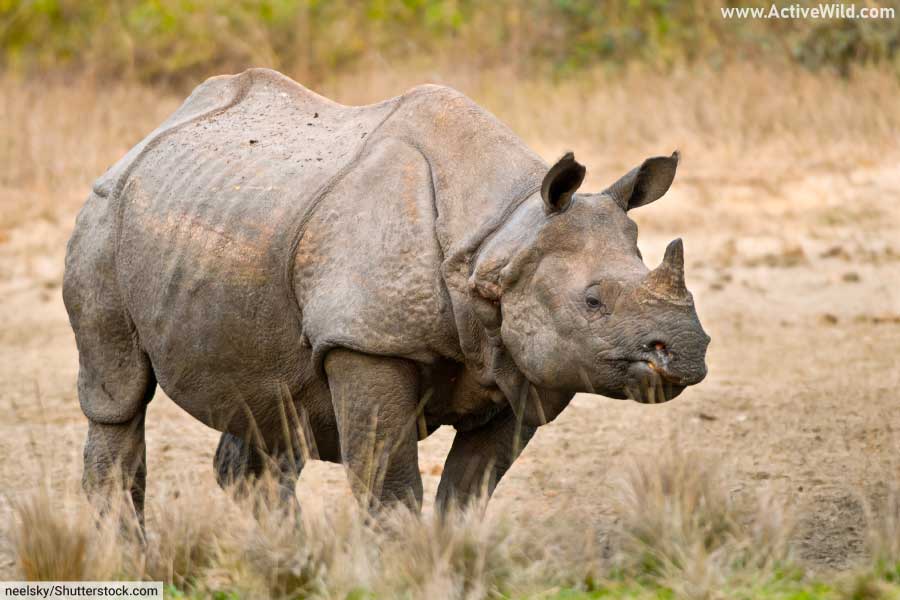
- Type of animal: Mammal
- Animal family: Rhinocerotidae
- Conservation status: Various
The name “rhinoceros” means “nose-horned”, and refers to the rhino’s distinctive horns. There are five species of rhino. Two of which, the white rhino and the black rhino, are found in Africa. The other three species – the Indian, Javan and Sumatran rhinoceroses – are found in Asia.
The rhino species most at home in grasslands are the white rhino and the Indian rhino. The white rhino is found in grasslands and savannas in southern Africa; the Indian rhino lives on grasslands south of the Himalayas in Asia.
The white and Indian rhinos are the only rhino species not to be critically endangered, although they are threatened; the conservation status of the white rhino is “Near Threatened”, and the Indian rhino is “Vulnerable”.
Rhinos are threatened by poaching for their valuable horns, and by habitat loss.
Discover More With Active Wild
You can find out more about rhinos on this page: Rhino Facts
Zebras

- Type of animal: Mammal
- Genus: Equus
- Family: Equidae
- Conservation status: Various
Zebras are a group of hoofed herbivores closely related to the domestic horse. There are three zebra species: Grévy's zebra (Equus grevyi), plains zebra (E. quagga), and mountain zebra (E. zebra). All three are found in African grassland habitats, the mountain zebra preferring grasslands in mountainous regions.
While all three zebra species possess characteristic black and white stripes, the patterns differ between each species, having varying degrees of thickness, spacing, and placement. Likewise, individual zebras of the same species can be identified by the unique pattern of their coats.
All three zebra species are highly social and territorial.
Zebras can run at speeds of up to 69.2 km / 43 mph, which enables them to escape grassland predators such as lions, leopards, and hyenas.
Discover More With Active Wild
You can find out more about zebras on this page: Zebra Facts
You can find out more about the plains zebra on this page: Plains Zebra Facts
Grassland Animals Of Australia
Agile Wallaby
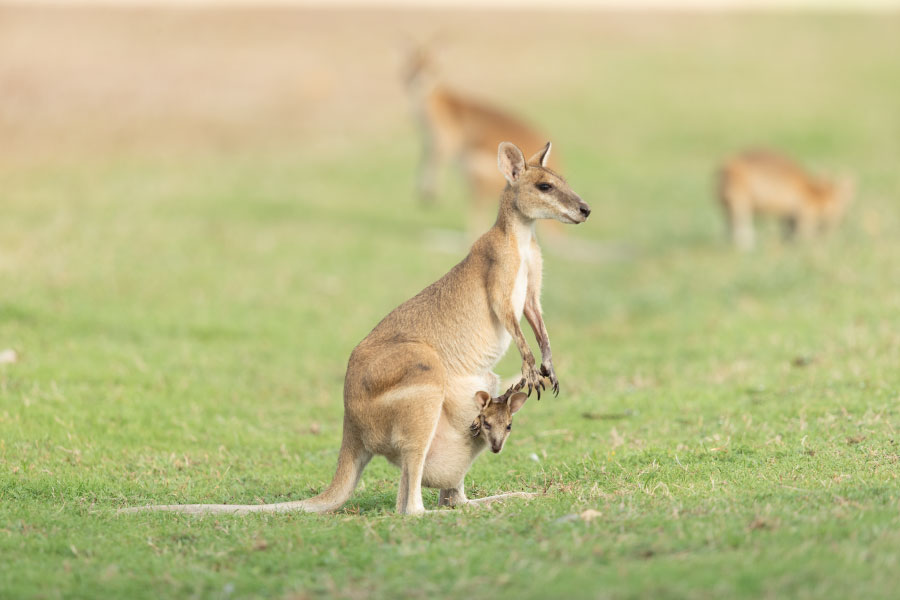
- Scientific name: Macropus agilis
- Type of animal: Mammal (marsupial)
- Animal family: Macropodidae
- Conservation status: Least Concern
The agile wallaby is the most common wallaby in northern Australia. The species is also found on the island of New Guinea. It has a sandy-red coat, giving it the alternative name, “sandy wallaby”.
As well as grasslands, the agile wallaby is found in woodlands and dunes. It is most often found near rivers and streams. The species forms small groups when feeding in open habitats.
The agile wallaby belongs to the family Macropodidae, which is home to all wallabies and kangaroos, as well as some other related animals. There is no real difference between wallabies and kangaroos; the name “kangaroo” is given to the four largest members of the family.
Discover More With Active Wild
You can see more marsupials on this page: Marsupials List with Pictures & Facts
Eastern Grey Kangaroo
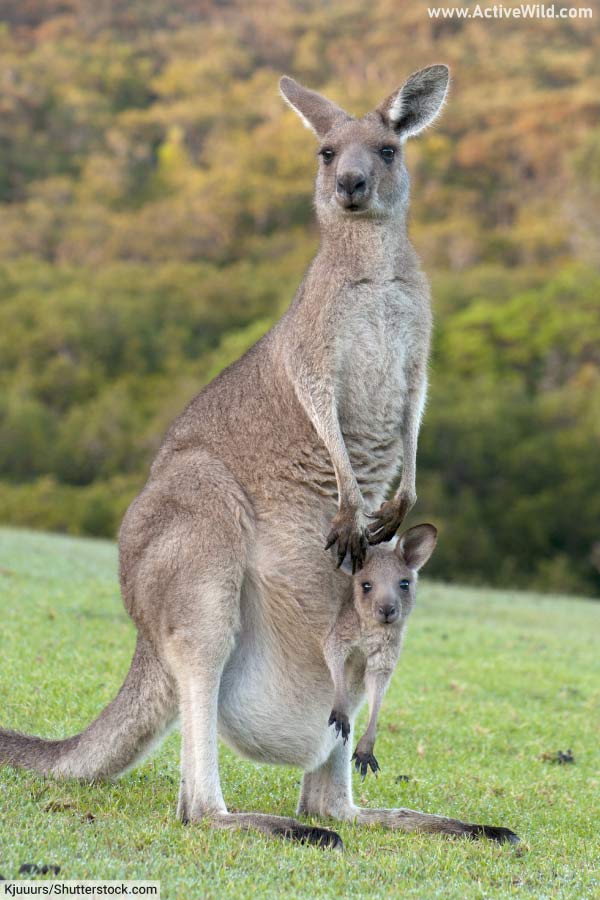
- Scientific name: Macropus giganteus
- Type of animal: Mammal (marsupial)
- Animal family: Macropodidae
- Conservation status: Least Concern
The eastern grey kangaroo is not just the second-largest kangaroo, it’s also the second-largest marsupial and the second-largest land mammal in Australia; only the red kangaroo is larger.
This large, gray-coated marsupial stands around 1.3 m / 4.27 ft tall, and has a 1 m / 3.28 ft. tail.
Like all macropods (members of the family Macropodidae), the eastern grey kangaroo moves by “hopping” rather than by running. A kangaroo’s elastic tendons store energy when the kangaroo lands, and release it when the animal hops. This is an extremely efficient means of travelling long distances at speed.
The eastern grey kangaroo is usually found in grasslands, and grass forms the bulk of its diet. The species will also inhabit woodlands and forests, and is found throughout much of eastern Australia.
Discover More With Active Wild
You can see more marsupials on this page: Marsupials List with Pictures & Facts
Plains-Wanderer
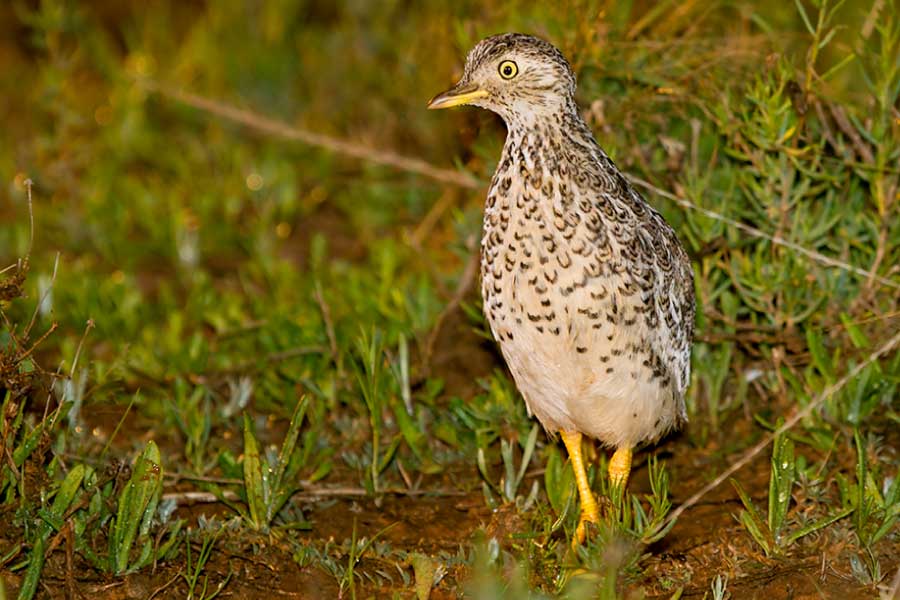
- Scientific name: Pedionomus torquatus
- Type of animal: Bird
- Animal family: Pedionomidae
- Conservation status: Endangered
The plains-wanderer is a partridge-like bird found in the grasslands of central and eastern Australia. The species is up to 19 cm / 7.48 in. in length and has a mottled brown / black plumage. The female has a black collar, and is larger than the male.
The plains wanderer is a poor flyer and rarely takes to the air, even when fleeing from danger.
The male plains-wanderer spends more time incubating the eggs and taking care of the young than the female.
Due to its ground-nesting habits and poor flying ability, the plains-wanderer makes easy prey for the red fox and other non-native species. This, and the conversion of its natural grassland habitat into farmland, has caused the plains-wanderer to become endangered.
Discover More With Active Wild
You can see more Australian birds on this page: Australian Birds List with Pictures & Facts
Discover more about birds on this page: Birds - The Ultimate Guide
See different types of birds on this page: Types of Birds
Western Barred Bandicoot
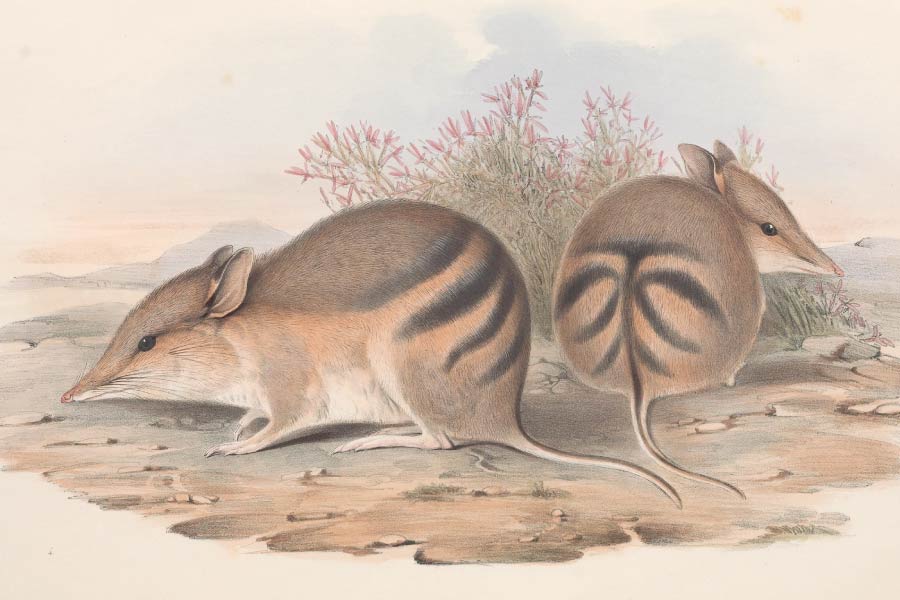
- Scientific name: Perameles bougainville
- Type of animal: Mammal (marsupial)
- Animal family: Peramelidae
- Conservation status: Vulnerable
The western barred bandicoot is the smallest of the bandicoots, a group of around twenty small or mid-sized marsupials with long, pointed snouts and sharp claws for digging.
Two dark bars running across the hindquarters of the western barred bandicoot its name. The species is around 1.5 ft / 46 cm in length.
The western barred bandicoot became extinct on mainland Australia, likely due to the introduction of non-native predators such as red foxes and cats. It survived on various islands, and has now been reintroduced to selected areas on the mainland.
Discover More With Active Wild
You can see more marsupials on this page: Marsupials List with Pictures & Facts
Grassland Animals of Eurasia
Corsac Fox
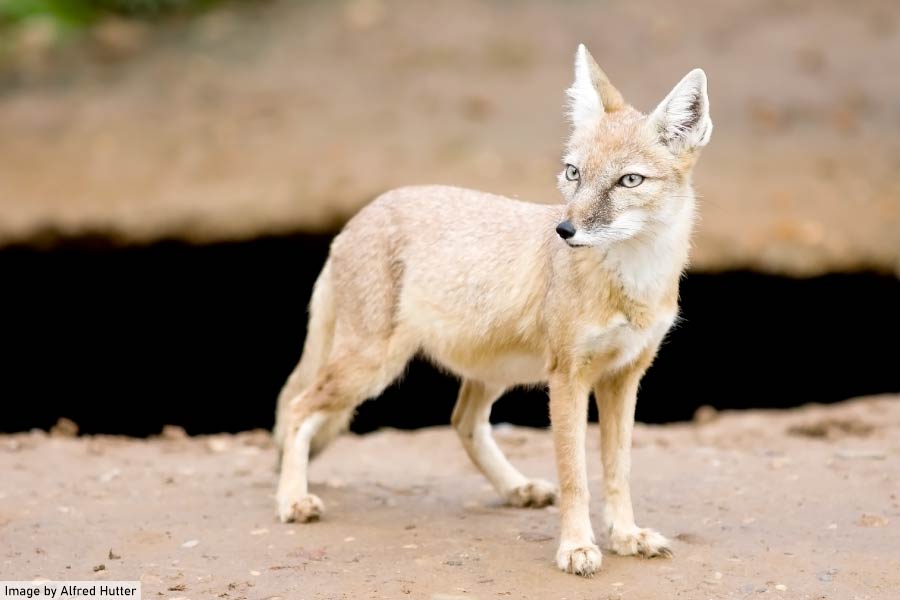
- Scientific name: Vulpes corsac
- Type of animal: Mammal
- Animal family: Canidae
- Conservation status: Least Concern
The corsac fox is a small canid (member of the dog family, Canidae) found on the steppes (large, grassland plains) of Central Asia.
The species is similar in appearance to the red fox, but with longer legs and ears and a pale yellow or reddish-grey coat.
The corsac fox is monogamous, and both parents participate in the rearing of the litter. A litter usually consists of 2 to 6 kits, but as many as 11 have been recorded.
Although not a fast runner, the corsac fox is an exceptional climber. A nocturnal carnivore, it feeds mainly on rodents and insects. Marmots are an important part of its diet in some areas.
The fox can survive for long periods of time without food or water – an adaptation for living in arid grasslands.
The corsac fox is a social animal, with unrelated individuals sometimes sharing the same burrow. During the winter when the prey is scarce the corsac fox may form small hunting packs, usually comprising a mated pair and their adult offspring.
Discover More With Active Wild
You can see EVERY species in the dog family on this page: Wild Dog Species List
Eastern Imperial Eagle
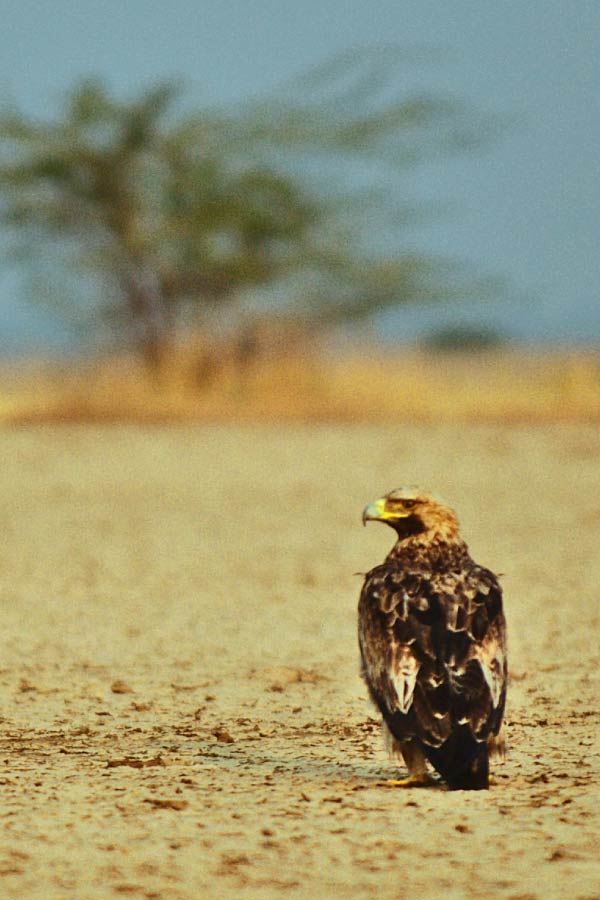
- Scientific name: Aquila heliaca
- Type of animal: Bird
- Animal family: Accipitridae
- Conservation status: Vulnerable
The eastern imperial eagle is widely distributed across its home range but it is classified as “Vulnerable” by the IUCN as its population is highly susceptible to human activities such as logging and other forestry operations that profoundly disturb its breeding patterns.
With a length of almost 1 m / 3.3 feet, a wingspan of 2.14 m / 7 feet, and a weight of around 3.6 kg / 8 lb. this eagle is the second-largest found in Europe.
The eastern imperial eagle is monogamous and will mate for life, starting breeding at around four years of age. If one of the breeding pair dies the remaining eagle will find a new partner. Both sexes participate in nest building, egg incubation, and chick rearing.
This raptor is territorial, with bonded pairs only interacting with other eastern imperial eagles during migrations.
Discover More With Active Wild
Discover more about birds on this page: Birds - The Ultimate Guide
See different types of birds on this page: Types of Birds
Great Bustard
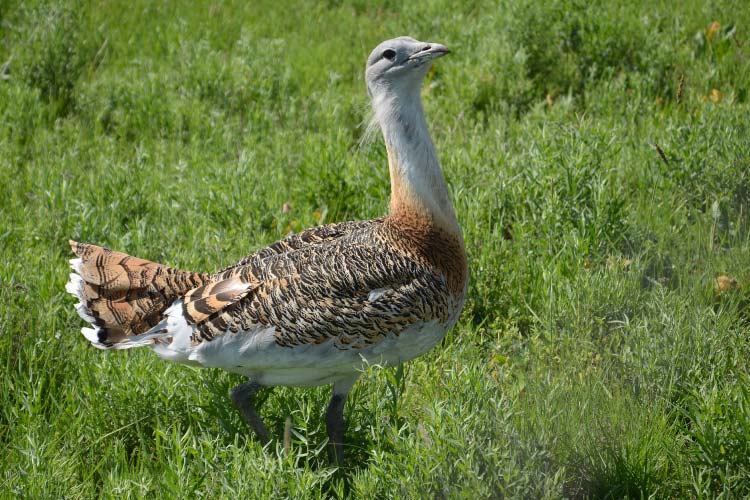
- Scientific name: Otis tarda
- Type of animal: Bird
- Animal family: Otididae
- Conservation status: Vulnerable
The great bustard is the joint-largest of the 26 bustard species (the Kori bustard is a similar size). These two birds are the world’s heaviest flying birds (only flightless birds, such as the ostrich and rhea, are larger).
Most bustards are grassland species, and the great bustard is no exception. It is found in grasslands from China and Russia in the east, to Spain and Morocco in the west.
The great bustard became extinct in Great Britain, but a small, reintroduced population lives in the Army Training base at Salisbury Plain.
Discover More With Active Wild
Discover more about birds on this page: Birds - The Ultimate Guide
See different types of birds on this page: Types of Birds
Pallas’s Cat
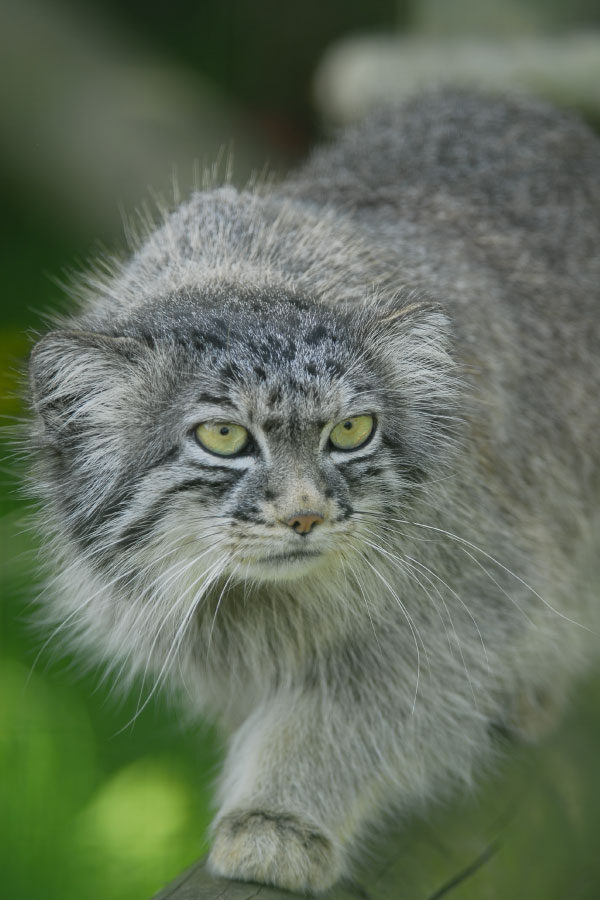
- Scientific name: Otocolobus manul
- Type of animal: Mammal
- Animal family: Felidae
- Conservation status: Least Concern
Pallas's cat is a similar size to a domestic cat, but has a more rounded face and shortened muzzle. Unlike many other cats, Pallas’s cat has rounded, rather than slit-shaped, pupils.
Pallas's cat is solitary and mainly nocturnal, although crepuscular behavior is also known. During the day, the cat rests in caves, or in the disused burrows of other animals.
Pallas’s cat feeds mainly on pikas, ground squirrels and other small mammals, but it will occasionally also eat birds and insects. It relies on stealth to stalk or ambush its prey.
Pallas’s cat was historically hunted for its fur, but this practice is now prohibited. Today, the species’ main threat is poisoning. Although the cat isn’t directly targeted, many of the animals it hunts are agricultural pests and deliberately poisoned by farmers.
Discover More With Active Wild
You can see EVERY species of cat on this page: Wild Cats List
Przewalski’s Horse
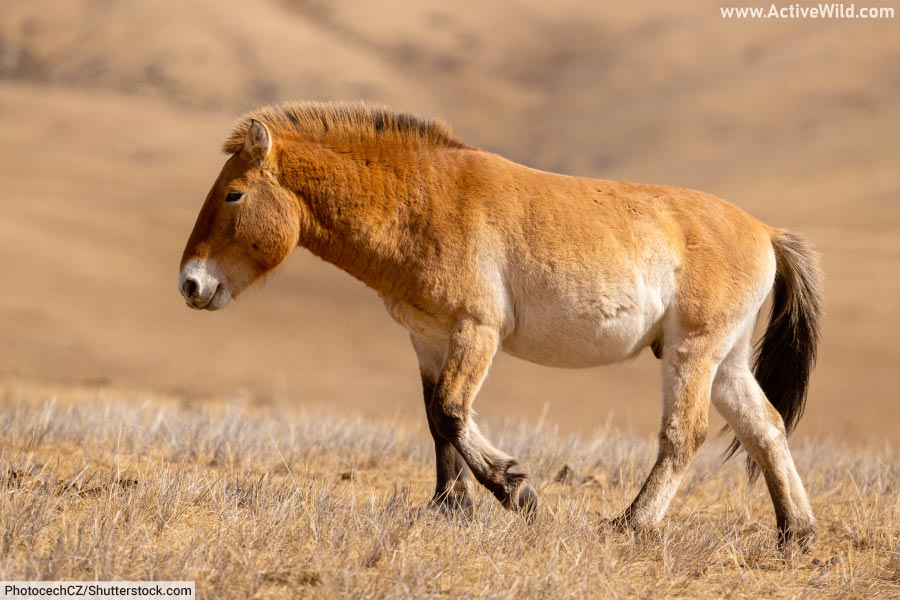
- Scientific name: Equus ferus
- Type of animal: Mammal
- Animal family: Equidae
- Conservation status: Endangered
Przewalski’s horse is a species of wild horse found in the Steppes of Central Asia. It has a pale reddish-brown coat with white undersides, and is shorter and stockier the domesticated horse.
During the 1960’s, Przewalski’s horse became extinct in the wild. This was caused by a number of factors, including hunting, habitat loss and military activities.
Reintroduction of the species from captive animals began in the 1990’s, and today Przewalski’s horse is once again roaming its natural grassland habitat.
Przewalski’s horse is herbivorous and social, living in herds comprised of mares with their foals and a dominant male. Young males will form temporary bachelor groups.
After a gestation period of around 12 months, a mare will give birth to a single foal.
Discover More With Active Wild
You can find out more about Przewalski’s horse on this page: Przewalski’s Horse Facts
Saiga Antelope
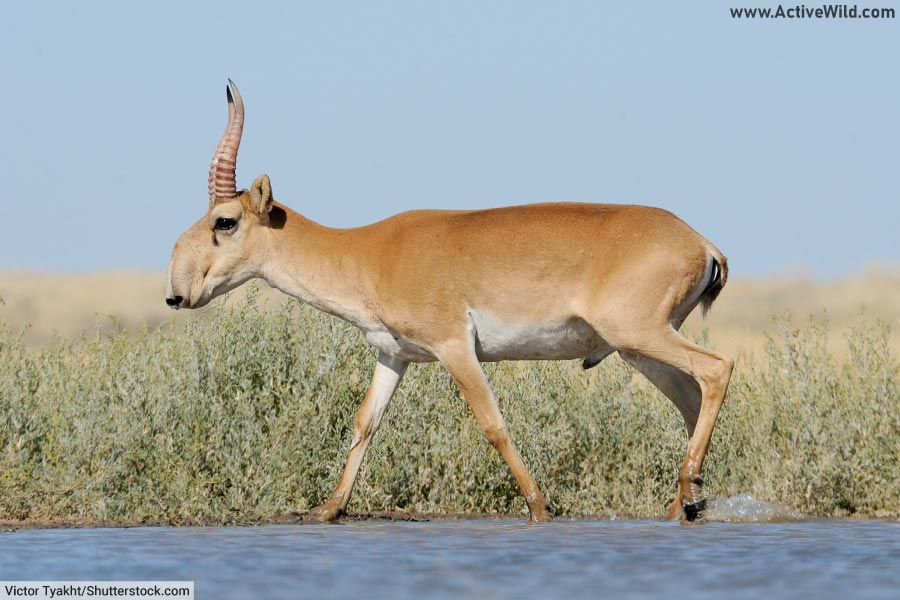
- Scientific name: Saiga tatarica
- Type of animal: Mammal
- Family: Bovidae
- Conservation status: Critically Endangered
The saiga antelope is an antelope found on steppes (dry grasslands) and deserts in Asia. The species is found in four countries: Kazakhstan, Mongolia, Russian Federation and Uzbekistan, but its dwindling population is fragmented into five separate populations.
The saiga’s distinctive, downward-pointing nostrils are a useful adaptation for life in dry grasslands, filtering out dust, cooling the antelope in the summer and warming the air the animal breathes in during the winter.
Once found in vast herds, the saiga was heavily hunted until just one thousand individuals remained. Sadly, various political and economic changes in the region have prevented the species’ population recovering to its original size, and today the saiga antelope is critically endangered.
Discover More With Active Wild
You can see other strange-looking animals on this page: Ugly Animals List
Love weird and wonderful animals? Check out our book: Ugly Animals Book
Steppe Eagle
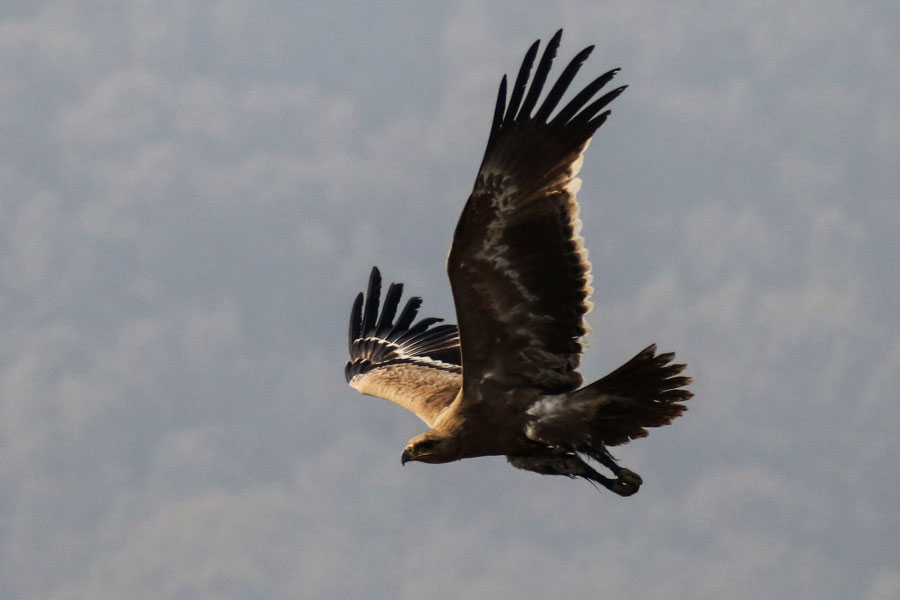
- Scientific name: Aquila nipalensis
- Type of animal: Bird
- Animal family: Accipitridae
- Conservation status: Endangered
The steppe eagle is a large raptor with a length of up to 80 cm / 31.5 in., and wingspan of 2 m / 6.6 feet. As is the case with many raptors, females are larger than the males. Males weigh around 3.5 kg / 7.7 lb., while females are around 4 kg / 8.8 lbs. Aside from the size difference, males and females are similar in appearance.
Rodents and small mammals up to the size of a hare form the bulk of the steppe eagle’s diet, although it will also eat other birds, amphibians, reptiles, and even carrion.
Unusually for a bird of prey, the steppe eagle often hunts on the ground, pursuing or ambushing its prey on foot.
Discover More With Active Wild
Discover more about birds on this page: Birds - The Ultimate Guide
See different types of birds on this page: Types of Birds
Grassland Animals of North America
American Badger
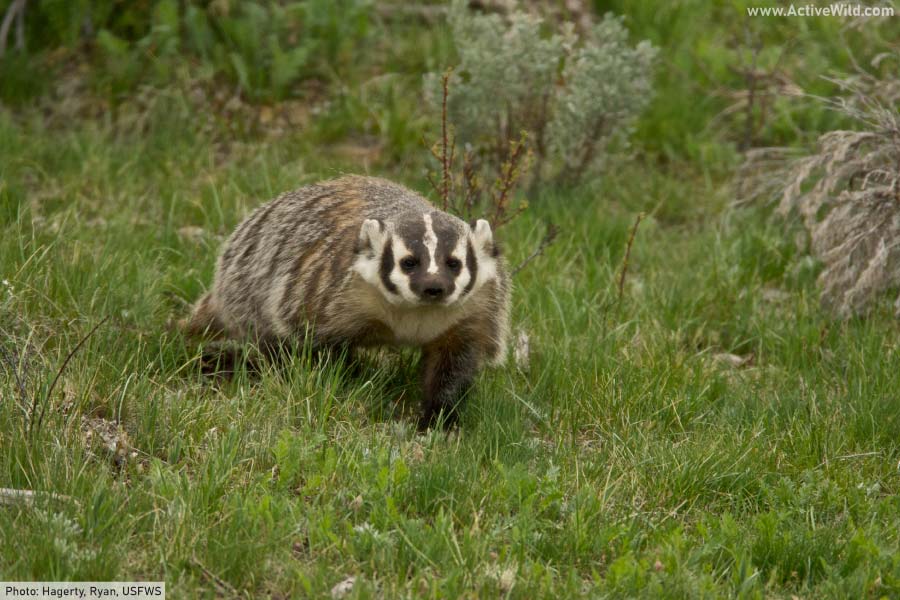
- Scientific name: Taxidea taxus
- Type of animal: Mammal
- Animal family: Mustelidae
- Conservation status: Least Concern
The American badger is a solitary, nocturnal mammal that spends the day sleeping in burrows around 3 m / 9.8 feet below the surface.
Although not a true hibernator, the American badger enters periods of torpor (very low activity) lasting up to 29 hours at a time during the winter months.
The American badger is carnivorous, preying mostly on small mammals such as pocket gophers and rodents. It will also prey on ground-nesting birds, reptiles, and amphibians.
While the predation of an adult badger is rare, it does have a few natural predators, including bobcats, golden eagles, bears, cougars, and wolves.
Discover More With Active Wild
You can find out more about the American badger on this page: American Badger Facts
American Bison
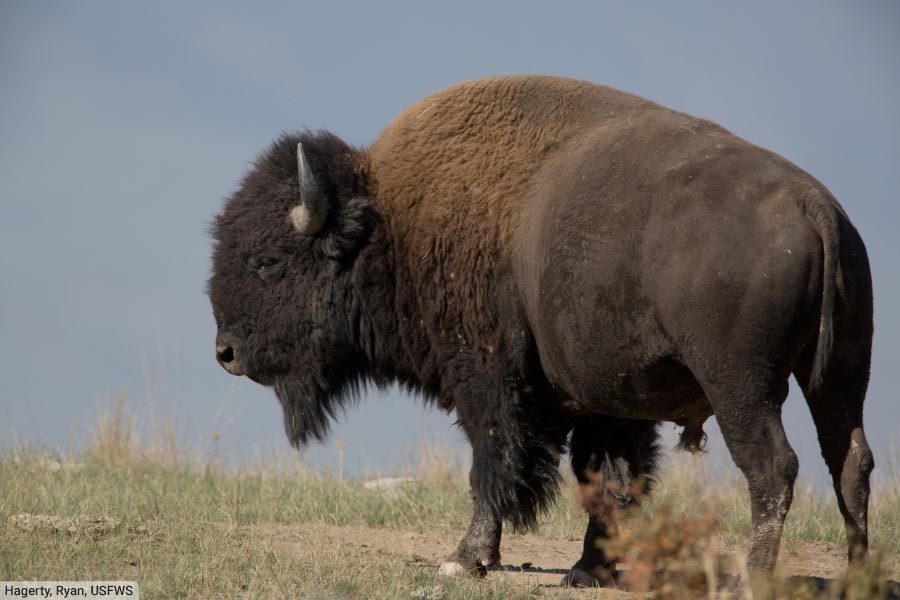
- Scientific name: Bison bison
- Type of animal: Mammal
- Animal family: Bovidae
- Conservation status: Near Threatened
The American bison is one of two bison species, the other being the European bison. Whereas the European bison inhabits woodland or shrubland habitats, the American bison is found on prairies and other grassland habitats.
The American bison is also known as the buffalo, although it is not closely-related to the Old World buffalo species.
The American bison is the largest land animal of North America. A large male can reach a length of 3.8 m / 12.5 feet, a height of 1.86 m / 6.1 feet at the shoulder, and a weight of around 900 kg / 1984 lbs. It has a very large and characteristic shoulder hump.
This large ungulate is entirely herbivorous and spends most of the day grazing. It is a social animal that lives in single-sex herds that usually only mix during the breeding season.
Despite its large size, the bison is surprisingly fast, and can reach speeds of 62 km / 39 miles per hour. It is also a good swimmer.
Discover More With Active Wild
You can find out more about the American bison on this page: American Bison Facts
Burrowing Owl

- Scientific name: Athene cunicularia
- Type of animal: Bird
- Animal family: Strigidae
- Conservation status: Least Concern
The burrowing owl is a small owl found in grasslands in both North and South America. Although a similar length to a mid-sized passerine such as a common blackbird or American robin, the burrowing owl is stockily built and may weigh over twice as much as those species.
The species can be recognized by its small size, mottled brown / white plumage, distinctive pale “eyebrows”, and long legs.
The owl’s long legs are an adaption for living in grasslands; they allow the owl to chase after its prey on foot.
Despite its common name, the burrowing owl is more likely to live in the abandoned burrow of another animal rather than digging its own, which it only does if no other burrows are available and the ground is soft enough.
If threatened, the burrowing owl makes a rattlesnake-like sound from its burrow, which is often enough to deter a predator.
The owl’s diet consists of small vertebrates (mainly mammals such as voles and mice but also birds, lizards and reptiles) and large insects. It hunts by swooping down at passing prey from a perch.
The burrowing owl is likely to be active at any time of the day or night.
Discover More With Active Wild
Test your knowledge of North American birds with our quiz app: North American Bird ID Quiz
Discover more about birds on this page: Birds - The Ultimate Guide
See different types of birds on this page: Types of Birds
Coyote

- Scientific name: Canis latrans
- Type of animal: Mammal
- Animal family: Canidae
- Conservation status: Least Concern
The coyote is a mid-sized canid (member of the dog family, Canidae) found in North America. It inhabits prairies, forests and deserts, and is more likely to be found near human settlements than its close relative, the gray wolf.
Less social than the gray wolf, the coyote lives alone or in small family groups. It is mostly nocturnal, spending the day in a den. Coyotes either excavate their own dens, or use those of other animals. A coyote will use the same den year after year and will always leave the den to urinate and defecate to ensure it remains clean.
The coyote is an extremely resilient and adaptable animal. It will enter urban environments to find food, and may even prey on pet dogs and cats.
The coyote is highly agile and can jump distances up to 4 m / 13 feet.
Discover More With Active Wild
You can see EVERY species in the dog family on this page: Wild Dog Species List
You can find out more about the coyote on this page: Coyote Facts
Great Plains Toad
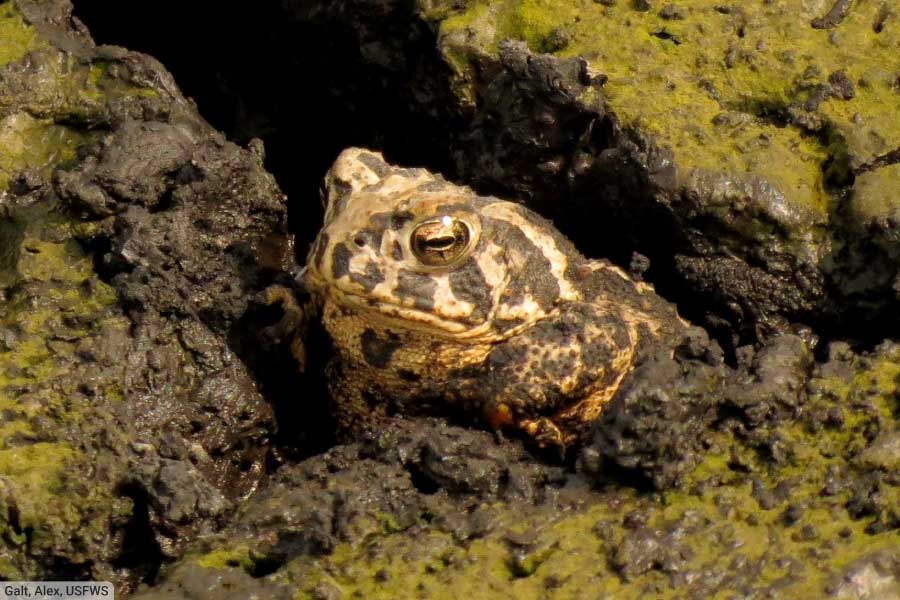
- Scientific name: Anaxyrus cognatus
- Type of animal: Amphibian
- Animal family: Bufonidae
- Conservation status: Least Concern
The great plains toad is a medium-sized toad found in prairie and desert regions of Canada, the USA and Mexico. The species can be recognized by the large, dark green patches on its back. These contrast strongly against a pale green background.
Another distinguishing characteristic of the species is a bump (known as a “boss”) between the eyes.
The toad is nocturnal for most of the year, but during the breeding season may also be seen out and about during the day. When not active it spends the day underground in burrows.
An insectivore (insect-eater), the great plains toad is very beneficial to farmers as it is a great natural pest controller.
The toad’s breeding season takes place from spring to early summer. Mating takes place after heavy rainfall, when the male great plains toad can be heard making its loud mating call. A single female may lay as many as 45,000 eggs.
Discover More With Active Wild
You can find out more about amphibians on this page: Amphibians - The Ultimate Guide
You can discover more American amphibians on this page: North American Amphibians List with Pictures & Facts
Prairie Falcon
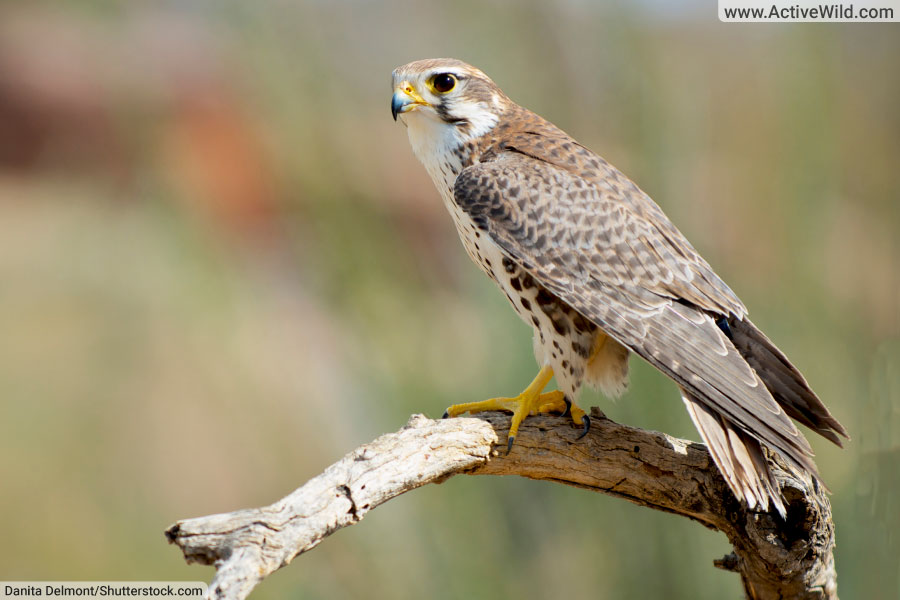
- Scientific name: Falco mexicanus
- Type of animal: Bird
- Animal family: Falconidae
- Conservation status: Least Concern
The prairie falcon is a large (crow-sized) falcon found in dry grasslands and deserts in North America. It has grey-brown wings and back, a pale chest with dark streaks / spots, white “eyebrows” and a thin “moustache”.
Like the closely-related peregrine falcon, the prairie falcon will perform a high-speed dive (known as a “stoop”) to knock other birds out of the air. It will also capture prey by flying close to the ground at high speed, or by flying upwards into a passing flock of birds.
In addition to birds, the prairie falcon will also regularly hunt mammals up to the size of jackrabbits, with ground squirrels being a particularly important prey item in many areas.
The prairie falcon exhibits serial monogamy, having only one mate per breeding season. The prairie falcon is solitary for the rest of the year.
The prairie falcon plays a very important role in its ecosystem as it helps to control the population of ground squirrels.
Discover More With Active Wild
Discover more about birds on this page: Birds - The Ultimate Guide
See different types of birds on this page: Types of Birds
Prairie Dogs
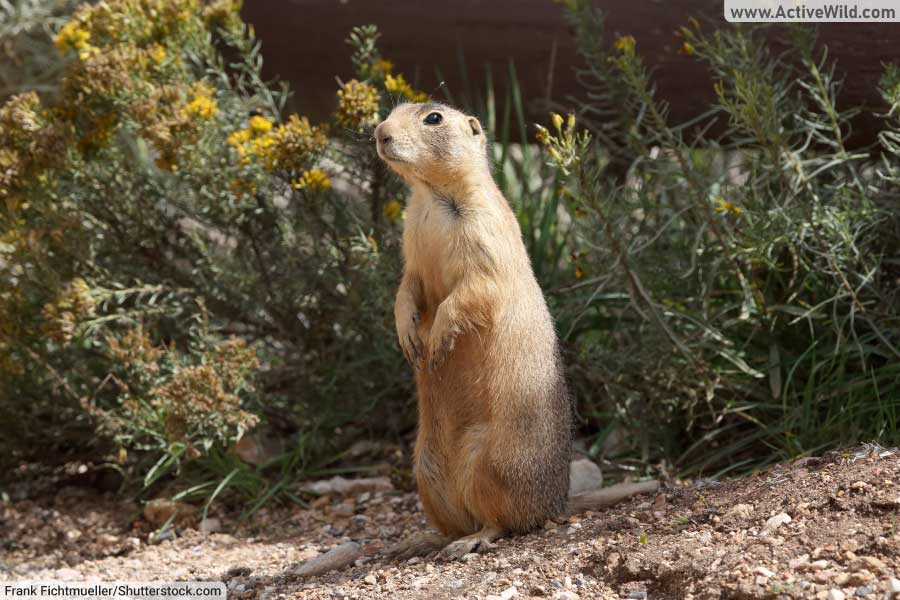
- Type of animal: Mammal
- Order: Rodentia
- Family: Sciuridae
- Genus: Cynomys
- Conservation status: Various
Prairie dogs are herbivorous ground squirrels widespread through the grasslands of North America. These mid-sized rodents are diurnal (active during the day).
The “dog” part of the prairie dog’s name comes from the rodent’s dog-like warning bark.
There are five species of prairie dog: the Mexican prairie dog, black-tailed prairie dog, white-tailed prairie dog, Gunnison's prairie dog, and Utah prairie dog.
Together, these five species make up the genus Cynomys, which is part of the squirrel family, Sciuridae.
All species of prairie dogs are about the same size, reaching a weight of 1.7 kg / 3.7 lb. and a length of 33 cm / 13 in. They have stocky bodies and short tails. Males are slightly larger than females.
Prairie dogs are well known for their intricate burrows; the largest-known example of which was located in Texas. At 100 miles wide and 250 miles long, it was estimated to be home to a colony of around 400 million prairie dogs!
Prairie dogs are considered “keystone species” due to the importance of their burrows – both as homes for other animals and for improving the quality of the soil – and also for the importance of the prairie dogs themselves as prey for other species.
Prairie dogs are capable of damaging crops, and their populations have been drastically reduced due to persecution by farmers.
Discover More With Active Wild
You can find out more about rodents on this page: Rodents - The Ultimate Guide
Prairie Rattlesnake
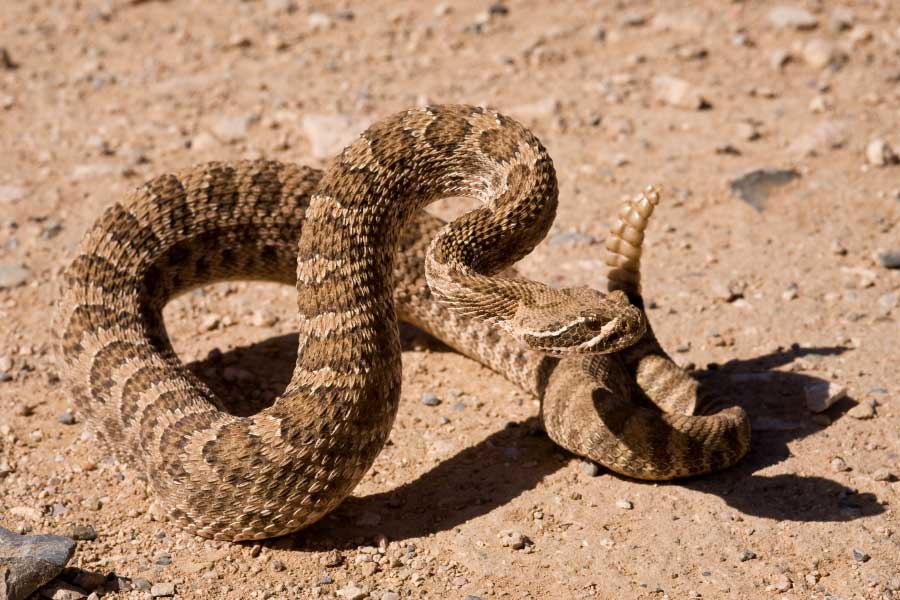
- Scientific name: Crotalus viridis
- Type of animal: Reptile
- Animal family: Viperidae
- Conservation status: Least Concern
The prairie rattlesnake, also known as the Great Plains rattlesnake, is found in grasslands from southern Canada to northern Mexico. It is one of the 56 species of rattlesnakes that are currently recognized (53 species are of genus Crotalus, the remaining three are of genus Sistrurus).
The prairie rattlesnake is generally a pale brown / pale olive-green color with a pattern of darker patches running along its body. A new bead is added to the snake’s rattle each time it sheds its skin (each segment is actually a hollow, hardened scale).
The species typically lives in rocky areas, and will inhabit the deserted dens of other animals. (Reports of the prairie rattlesnake sharing dens with other animals are untrue.)
The vision of rattlesnakes is not particularly acute, and the reptiles are better able to perceive movement rather than clear images.
All rattlesnakes possess an extremely acute sense of smell, being able to discern scents not only with their sensitive nostrils, but also with their tongues, which they flick in order to “taste” the air.
Rattlesnakes, being pit vipers, also have a “sixth sense”: the ability to sense heat with their “pit organs”, which are located between the eye and the nostril.
Discover More With Active Wild
You can find out more about the prairie rattlesnake on this page: Prairie Rattlesnake Facts
You can see more snakes on this page: Types of Snakes with Pictures & Facts
Swift Fox
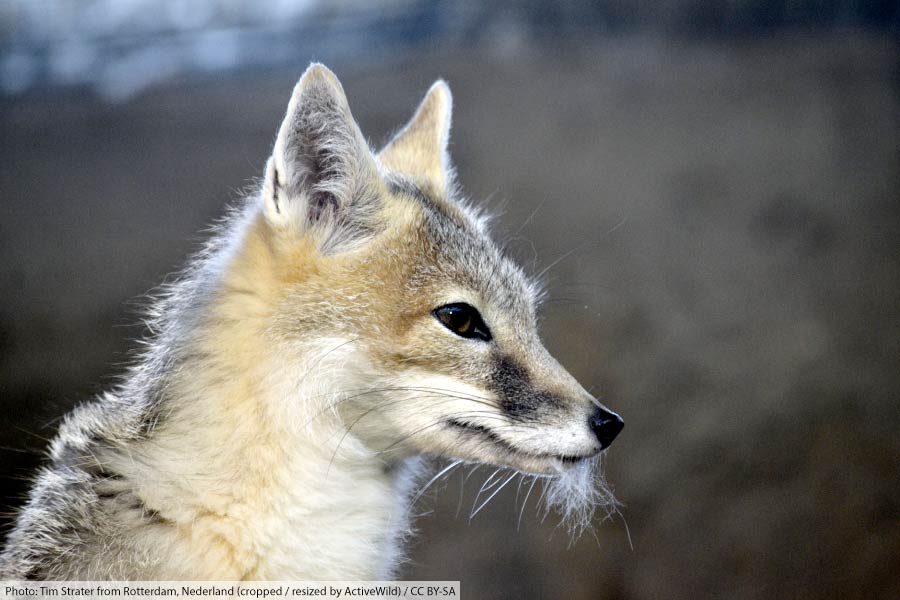
- Scientific name: Vulpes velox
- Type of animal: Mammal
- Animal family: Canidae
- Conservation status: Least Concern
The swift fox lives in the prairie grasslands of the Great Plains region of the United States and parts of southern Canada.
About the size of a Domestic Cat, the swift fox is pale yellow and white in color. Its ears are large and pointed. It is closely related to the kit fox, another North American canid.
During the early 20th century, as a result of heavy persecution, the swift fox was extirpated in much of its former range. Successful conservation and re-introduction programs have seen the species’ population bounce back.
Although the species is no longer considered to be threatened, today it is only present in 44% of its original range in the USA, and 3% of its original range in Canada.
Discover More With Active Wild
You can find out more about the swift fox on this page: Swift Fox Facts
You can see EVERY species in the dog family on this page: Wild Dog Species List
Grassland Animals Of South America
Big Hairy Armadillo
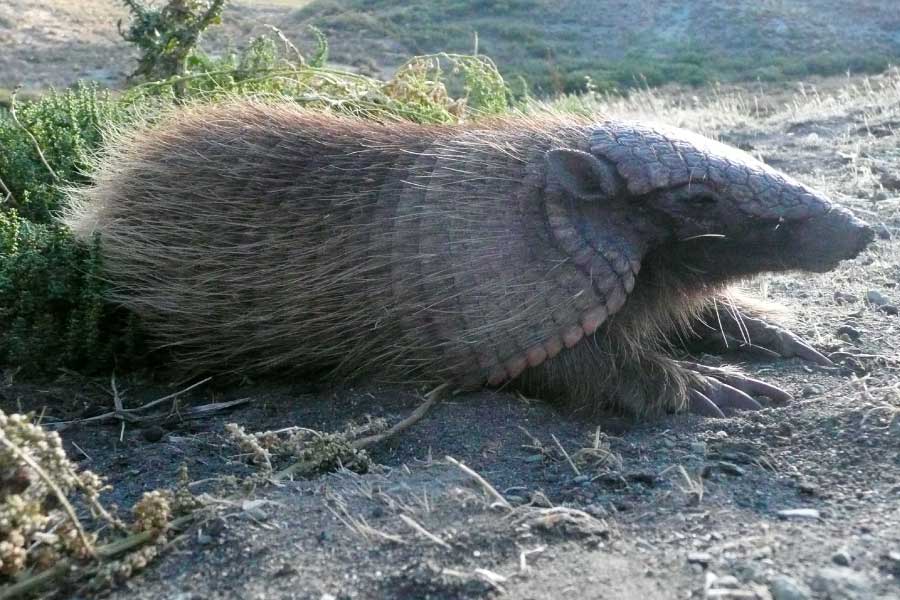
- Scientific name: Chaetophractus villosus
- Type of animal: Mammal
- Animal family: Chlamyforidae
- Conservation status: Least Concern
The big hairy armadillo is one of the largest of the 21 recognized species of armadillo alive today. (The largest is the giant armadillo, another South American grassland species.)
One of three “hairy” armadillos of genus Chaetophractus, the big hairy armadillo can be identified by its size (it grows to lengths of up to 40 cm / 15.75 in, not including the tail) and the hairs that grow on its undersides and between its armor. The big hairy armadillo has 18 bands of armor, of which around 8 are movable.
The big hairy armadillo is an omnivore. During the winter, over half of its diet consists of vegetation, while for the rest of the year it feeds mainly on insects, worms and other invertebrates, and well as on small vertebrates and carrion.
The big hairy armadillo is a strong digger with a mainly fossorial (burrowing) lifestyle, spending much of its life underground.
Discover More With Active Wild
You can find out more about armadillos and related animals on this page: Xenarthra Facts
Brazilian Guinea Pig
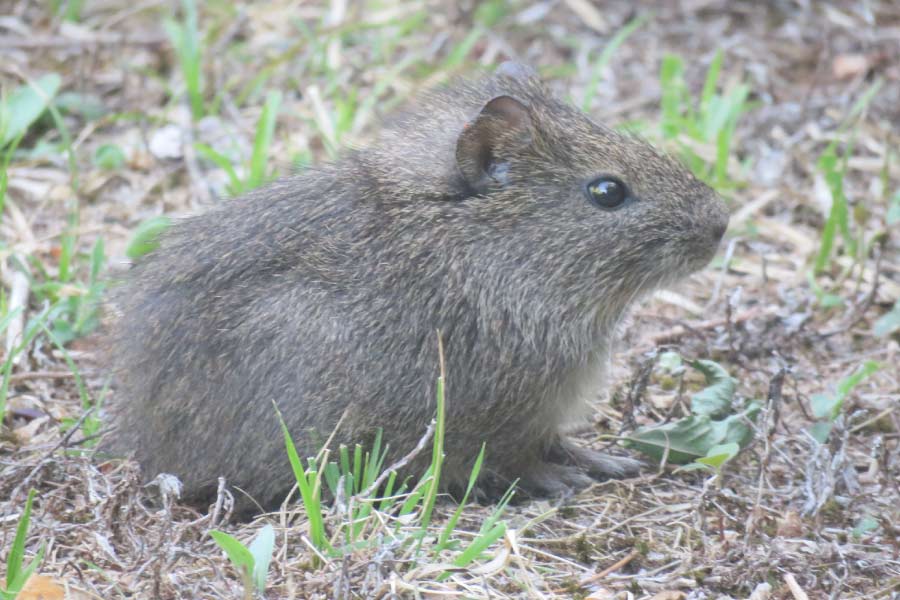
- Scientific name: Cavia aperea
- Type of animal: Mammal
- Animal family: Rodentidae
- Conservation status: Least Concern
The Brazilian guinea pig is a wild relative of the domestic guinea pig, Cavia porcellus. Both animals belong to the genus Cavia, which is also home to another five guinea pig species. Animals in this group are also known as cavies.
The Brazilian guinea pig is longer but slightly slimmer than the domestic species, reaching lengths of around 11 in. / 27.94 cm. Its coat is dark gray-brown; the undersides are pale.
This South American rodent is present in grasslands throughout much of the continent, from Venezuela through to northern Argentina.
The Brazilian guinea pig has a lifespan of up to 8 years in captivity, but due to the heavy predation the species faces, its average lifespan in the wild is 3 years.
Discover More With Active Wild
You can find out more about rodents on this page: Rodent Facts
Giant Anteater
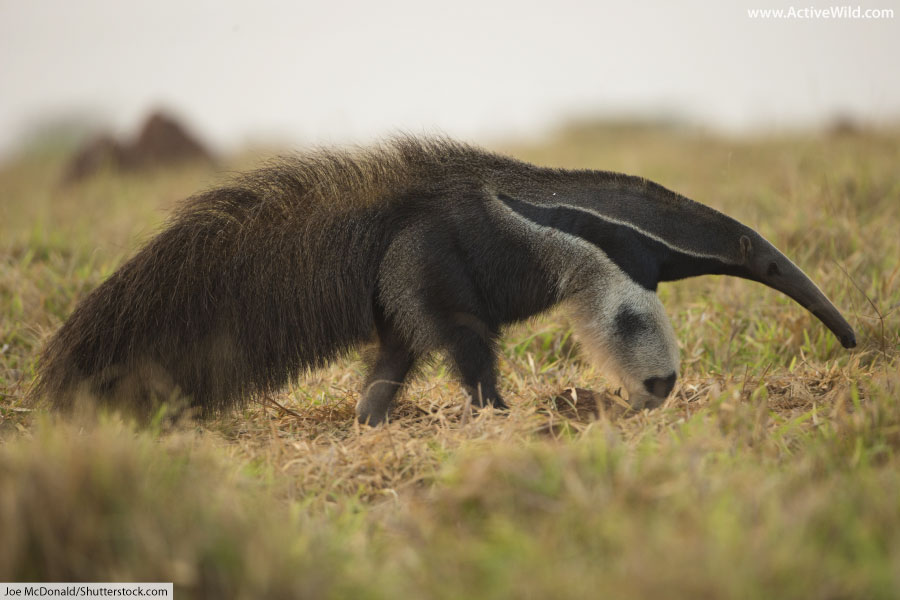
- Scientific name: Myrmecophaga tridactyla
- Type of animal: Mammal
- Animal family: Myrmecophagidae
- Conservation status: Vulnerable
The giant anteater is a large mammal found in the grasslands of Central and South America. It is a specialized insectivore (insect eater), easily identified by its long, thin snout, grey/black coat, and bushy tail.
Four of the toes on each of the anteater’s front feet are equipped with long, powerful claws. These are used to break into ant mounds. They also make excellent defensive weapons – a cornered giant anteater can be surprisingly dangerous!
The giant anteater’s long, thin snout is around 30 cm (12 in) in length. The species has no teeth, and its sticky tongue can be up to 60 cm (2 ft.) in length. Its eyes and ears are relatively small.
Using that long, sticky tongue, which can be flicked in and out of its mouth 150 times per minute, the giant anteater can consume up to 30,000 insects in a single day.
The giant anteater is usually solitary, only coming together to mate. Females give birth to a single offspring that is born with a full coat and markings identical to that of an adult.
The young anteater will climb onto its mother's back immediately after birth and stay there for up to nine months. Giant anteaters become independent at around 2 years of age.
Discover More With Active Wild
Discover more about the giant anteater on this page: Giant Anteater Facts
Discover more about anteaters on this page: Anteater Facts
Maned Wolf
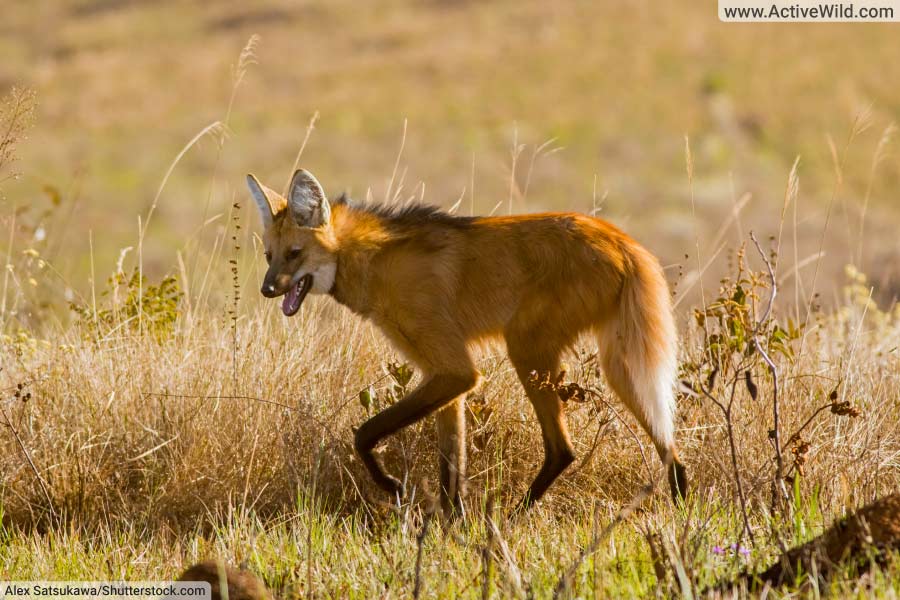
- Scientific name: Chrysocyon brachyurus
- Type of animal: Mammal
- Animal family: Canidae
- Conservation status: Near Threatened
The maned wolf is a canid (member of the dog family, Canidae) found in grasslands and open woodlands in Argentina, Bolivia, Brazil, Paraguay and Peru.
One of the most distinctive canids, the maned wolf has disproportionately long, thin legs that allow it to see above tall grass. It has a striking red coat and shaggy mane from which it gets its name.
The maned wolf is the largest canid found in South America, and also the tallest of all wild dogs.
With an average weight of 23 kg (51 lb.), and shoulder height of 90 cm (35 in), the maned wolf is taller, but significantly lighter, than the gray wolf.
The maned wolf has a peculiar social dynamic: although monogamous, the male and female will live independently, within a shared home range, only coming together during the breeding season.
An omnivore, the maned wolf eats small and medium vertebrates such as rodents, rabbits and birds, as well as a variety of plant matter.
Discover More With Active Wild
You can see EVERY species in the dog family on this page: Wild Dog Species List
- Scientific name: Ozotoceros bezoarticus
- Type of animal: Mammal
- Animal family: Cervidae
- Conservation status: Near Threatened
Pampas Deer
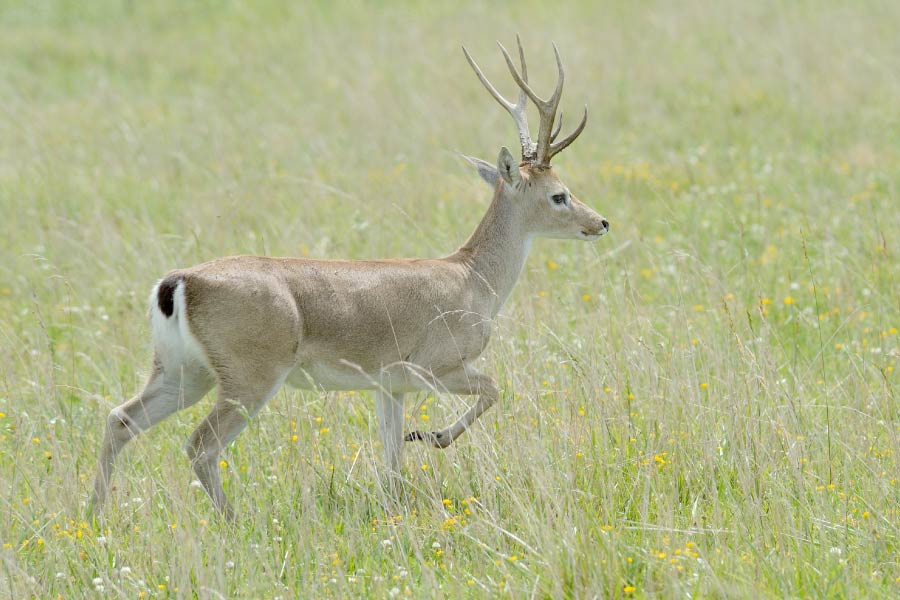
The pampas deer is an ungulate (hoofed mammal) belonging to the deer family, Cervidae. It is found in grasslands in Argentina, Bolivia, Brazil, Paraguay and Uruguay, with Brazil being home to the majority of the species’ estimated population of 80,000 individuals.
This mid-sized deer stands 0.75 m / 2.46 ft. at the shoulders, and has a pale reddish-gray coat. Its undersides are white. Like all deer, it is a herbivorous browser.
The pampas deer was hunted in vast quantities during the nineteenth century, and the population of this once abundant animal is now heavily fragmented.
The persecution of the pampas deer in South America has been likened to that of the American bison in North America.
Discover More With Active Wild
You can see more animals with horns on this page: Animals With Horns
Pampas Fox
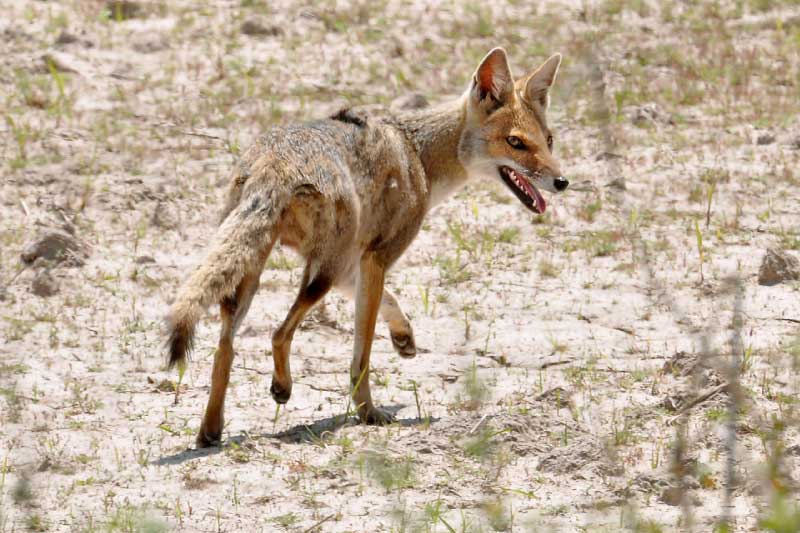
- Scientific name: Lycalopex gymnocercus
- Type of animal: Mammal
- Animal family: Canidae
- Conservation status: Least Concern
As its name suggests, the Pampas fox is found in the South American Pampas. These vast lowland grasslands are located in Argentina, Brazil and Uruguay.
The Pampas fox, being a member of the South American genus Lycalopex, is a ‘zorro’, or ‘false fox’, rather than a ‘true fox’ of genus Vulpes. However (like all zorros) it is typically fox-like in appearance, having a pointed snout, erect ears and a bushy tail.
The species’ sandy-colored coat provides camouflage in the dry grasslands and sandy terrain in which the species is commonly found.
Discover More With Active Wild
You can see EVERY species in the dog family on this page: Wild Dog Species List
Rhea
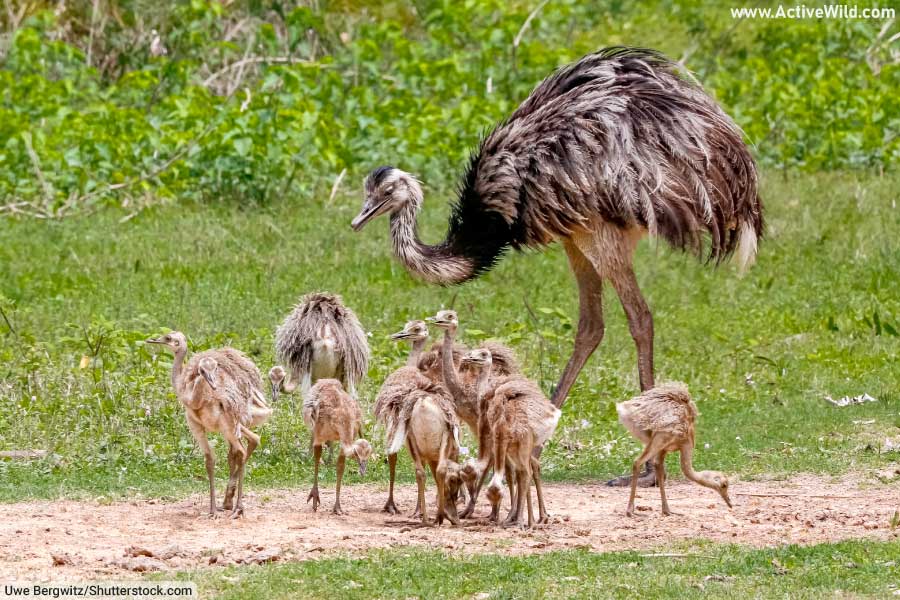
- Type of animal: Bird
- Order: Struthioniformes
- Family: Rheidae
- Genus: Rhea
- Conservation status: (Greater rhea) Near Threatened; (Lesser rhea) Least Concern
Rheas are large, flightless birds found in grasslands and pampas in South America.
These distinctive birds are known to form mixed herds with deer and guanacos (a South American member of the camel family), a behavior thought to improve its chances of survival.
There are two species of rhea: the greater rhea Rhea americana (conservation status: Near Threatened); and the lesser rhea Rhea pennata (also known as Darwin’s rhea, ñandú petiso, or ñandú del norte) (conservation status: Least Concern).
Some authorities recognize a third rhea species, the Puna rhea Rhea tarapacensis (conservation status: Near Threatened).
The greater rhea is the largest species of rhea, and the largest bird of the Americas. It can reach weights of 40 kg (88 lb.), and has an average body length of 1.34 m (4.4 ft.). The species is the world’s seventh-largest bird by weight.
Although larger in size than the emperor penguin (the world’s sixth largest living bird), the greater rhea weighs less on average.
(The lesser rhea is the world’s tenth-largest bird by weight.)
Rheas belong to a group of flightless birds known as ratites, which also contains ostriches, the emu, cassowaries and kiwis. The breastbones of ratites lack a keel, which is the part of the skeleton to which the wing muscles of flying birds are attached.
Discover More With Active Wild
Discover more about birds on this page: Birds - The Ultimate Guide
See different types of birds on this page: Types of Birds

